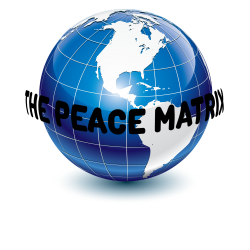(An excerpt of Volume I)
What’s so good about a diagram?
We all have some weaknesses we need to turn into strengths, like our level of organization perhaps. When I bring such a weakness into my conscious mind scope and focus on it, I can become incredibly organized, almost hyper-organized. Let’s call it “comfortable overshooting my mark.” And then I guess we’ll call this entire project, Exhibit A.
What makes the PeaceMatrix™ special is the back-end organization of how content and discussion forums and videos and 24/7 video conference rooms will be organized and presented. The PeaceMatrix™ is the set of rules for organizing and mapping out any complex dispute between viewpoints held by groups. Dr. Martin Luther King Jr. said, “Those who love peace must learn to organize as effectively as those who love war.” Maybe this is what he meant.
In most disputes, most of the other side is not evil. They merely see things differently, even if incorrectly according to us. All human beings have tendency for evil and good, depending on what is brought out. If you were drowning, a person on the other side of your current dispute would help you same as any human being. The problem is when human weaknesses and group divisions take over, making one group think another group is evil. Then, they’re reduced to trying to help their side instead of everyone.
But what does this diagram have anything to do with peacebuilding? What’s so good about a nerdy diagram?
Even our personal disputes are often too complex to grasp logically. In fact, we barely understand ourselves and why we do what we do. One quote by Emerson M. Pugh says, “If our brains were so simple that we could understand them, we’d be so simple that we couldn’t.” We barely understand our domestic relationships and the subconscious and underlying reasons why we do things, why things bother us, and why we have the relationships we do or even the partners we do. “Honey, why are you upset?”; “I don’t know, I just am.”
Disputes between different tribes, nations, cultures, religions, political groups, ideologies are infinitely even more complex. The factors and issues appear infinitely unmanageable. How can we possibly understand something like the Spanish Inquisition, the Crusades, any war, in which thousands or millions of people engaged? Each individual, let alone side, views a conflict differently. We know facts, but often don’t understand. That’s why historically, humanity has not had much success in being able to avoid war and conflict for more than a generation or two. We think we know why the last one happened and think we can prevent the next, and we are often wrong. And today, wars are even more easy to start with our trigger-ready long-range missiles, fighter jets, hacking, spyware, and drones everyone has now without the necessarily accompanying rules.
The PeaceMatrix™ allows something never before seen in human history – a comprehensive diagram of an entire complex dispute between groups.
Making an infinitely complex problem fit into one interactive diagram properly organized lets the entire world simultaneously collaborate on it. It brings everyone onto the same proverbial drawing board, with all the same guidelines and reference points. The more one thinks about this, the more earth-shatteringly valuable its potential becomes.
By comprehensive, I mean, the PeaceMatrix™’s 26 categories contain within them every major facet and element of the human experience that maintains a dispute …and thus every key for solving it. It allows for a map of the dispute that is comprehensive, comprehendible, and able to improve continuously as a fluid system.
What does it mean when two opposing parties, or ten, or ten thousand, can work on the same drawing board? Imagine a complex dispute about which hundreds of books might be written. If I read 50 books, and you read a different 50 books, we could both be extremely knowledgeable but not be on the same page. (No pun intended) And, we’d each have all the more evidence to more strongly believe we are each correct and the other is wrong. That’s why when intellectuals are wrong, it’s sometimes worse, because they can even more eloquently back up their error with beautifully-erroneous logic. A debate of 100 hours wouldn’t be enough to synchronize our views.
With the PeaceMatrix™, we start out on the same page. From. The. Beginning. Wherever each one goes, the others can see how they got there. It allows not merely two people to be on the same page, but thousands, millions, simultaneously, in real time, going from the general to the specific.
Let’s say in a discussion/negotiation/debate one or both parties lack certain knowledge of facts on whatever issue. The human attention span cannot organize and maintain all the facts and evidence. We are too emotional. A negotiation could never organize them all. Media is too soundbite and emotion-driven, with each side thinking the other is immoral and/or delusional, brainwashed by a conspiracy theory.
In reality, we’ve just reached our individual cognitive and emotional limitations. Many opinions are not our own. They are largely fed to us by our media, forcing us to receive increasingly one-sided information, and pushing us to polarized, over-emotionalized viewpoints, echo chambers and cognitive dissonance. We are emotional creatures who wrongly believe we are logical.
An organized diagram that anybody can follow can fix much of this. Imagine the usefulness in a discussion, mediation, debate or negotiation, of a diagram laying out every viewpoint, followed by the facts on all sides, followed by a critical examination of the pros and cons of each viewpoint and the support of each fact.
Imagine a diagram that maps out everything right and wrong with each position and idea. This diversity of perspective is precisely what is missing from the conversation today. The order to the chaos. It seeks to take us out of the “let’s destroy the other” mindset. By giving us little chewable doses of new viewpoints, instead of wiring deepening hate. The scientific approach can allow us to rationally dissect not only the other’s ideology, but our own. It’s the missing “science”, since everyone loves that word so much.
Without perspective, our peace tools in international affairs are almost useless. For example, take two messages. One, Hitler says the Jews are evil and dangerous to Germany, and two, Jews say Hitler is dangerous and a threat to the world. At the time, how do we know which is true? Today we know from hindsight, but many ordinary intelligent people, who were there at the time, sided with Hitler. Remember, it was not only illegal, but socially unacceptable to spread the second message, so the first one appeared more moral with nothing to controvert it. Hypothetically, if Hitler had won the War, and someone were raised under his propaganda as their only source of information, how would they know any other morality? Our global morality is built on thousands of years of the Bible and authors and poets and philosophers and wars and progress. One couldn’t make that up in their mind. Many people in North Korea today believe Kim Jung Un is the most wonderful person and theirs is the best political and economic system on earth.
The PeaceMatrix™ solution to the “perspective problem”, that we only see our perspective and not reality, is to build one diagram that maps out and examines the pros and cons of all viewpoints.
Instead of intelligent people merely talking, or merely debating, or merely writing books, or politicians and diplomats merely negotiating, why aren’t we all building something together?
If a diagram doesn’t sound like fun, imagine each node being a unique club with 24/7 live video-conferencing for live connection and engagement with other people all with the same goal – to solve the next piece of the puzzle. My goal is to make peace building interesting, to make it a hobby, and to make it engaging. To make it our art as humanity… and draw us to it.

